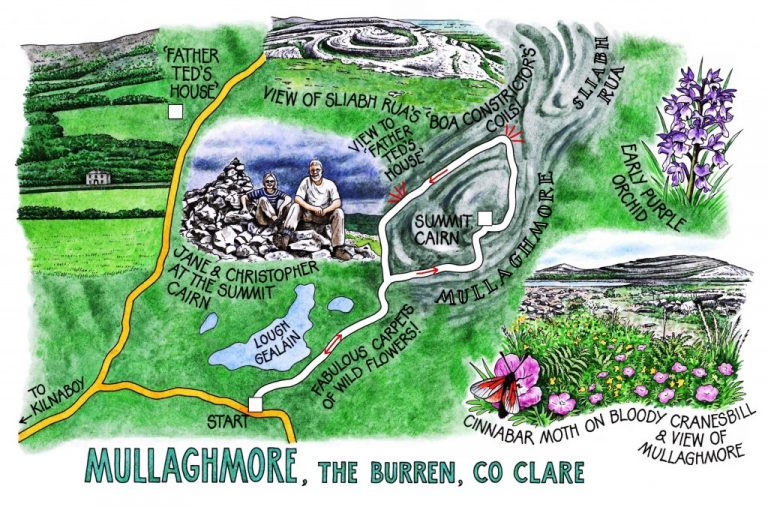 Irish Independent – WALK OF THE WEEK – Christopher Somerville
Irish Independent – WALK OF THE WEEK – Christopher Somerville
21 August 2010
71. Mullaghmore, The Burren, Co. Clare
There’s definitely some magic about the Burren region of County Clare – the naked limestone hills so packed with wildlife, yet so seemingly empty; the bare grey landscape that hides a fabulous treasury of archaeological sites; the sleepy one-tractor villages where music springs at full flow from plain-looking pubs. When you fall in love with this mysterious place, you fall hard. The first time I clapped eyes on Mullaghmore in the south-east corner of the region, 20 years ago, I reckoned it my favourite hill in all the world, and I haven’t changed my mind since.
Now that the Burren National Park has laid out a modest but excellently waymarked network of paths over Mullaghmore, there’s no need to scramble up the fractured cliffs by the tips of your fingers. But nothing can tame this magnificent swirl of contorted limestone. When you glimpse it first, you gasp and wonder if you’re seeing things. It’s as if a giant has grabbed Mullaghmore and its neighbouring peak of Sliabh Rua and given them a vigorous twist. They curl and bend in a way that stone just isn’t supposed to do. They beckon you to explore.
Setting off from a lane in the back of beyond north of Kilnaboy, Jane and I skirted Lough Gealáin at the foot of the hill. A turlough or seasonal lake, it lay half-dried, its shores and shallows powdered with lime dust over which the water shone a clear, Mediterranean turquoise. We squelched out onto the mud and were rewarded with the spectacle of the biggest, baddest black leech you ever did see.
Up on the slopes of Mullaghmore the grey limestone was alive with wild flowers. One of the Burren’s many magicalities is the way that lime-loving and acid-loving flowers cosy up together. Flora of the heights grows contentedly at sea level; plants of the low places flourish halfway up the hills. The sun-warmed stone, the damp and shelter in the cracks called grykes, the acid seeps and calcareous drips all conspire to allow the heather to lie down with the gentian, and the bog asphodel with the primrose.
Jane the trained botanist was in heaven, kneeling among crinkly yellow rockrose and the creamy porcelain-thin cups of mountain avens, musing over orchids that might be early purples in late flower or pyramidals at some other stage. I walked slowly, enjoying the buzz-saw symphony of grasshoppers and bees. A slender bar of neon as long as my little finger materialised beside me, then vanished, to reappear five feet off – a damselfly, as brilliantly blue as a kingfisher’s back.
The walk at this lower level was a series of small, intimate images. A peregrine falcon chittering away, a dark and deadly little hunter flashing along the pale grey cliffs. A silver-washed fritillary butterfly settling on a rock to sun its leopard-spotted wings. Two crimson and black cinnabar moths mating on a grass stalk. A purple flower of bloody cranesbill collapsing under the weight of a corpulent bumble bee.
Shards of dry limestone clinked like china underfoot. We climbed the faint trail up miniature passes in the crags, the reflected heat from the limestone beginning to flush our necks and cheeks, to top out by the pointed summit cairn. Now for the view over the grey sweep of the Burren landscape, the lime-crusted turloughs like flakes of abalone, the hidden spirals and vortices of rock that you’ll never see except from up here on the roof of Mullaghmore.
On the north slope we stopped to savour the full measure of the strangeness of Sliabh Rua and its thick twists of limestone, as though an ash-coloured boa constrictor had wrapped its coils round the neck of the secondary hill. Then it was back along the western slopes. Glancing across the valley, Jane suddenly exclaimed: ‘Father Ted’s house!’ So it was, unmistakeably: standing back on its own, square and grey, with that familiar white front door. A great thirst for a cup of tea suddenly descended on us. ‘Ah, you will!’ we said simultaneously, and burst out giggling.
WAY TO GO
MAP: OS of Ireland 1:50,000 Discovery 52; Folding Landscapes map ‘The Burren’ (www.foldinglandscapes.com); Burren National Park Walking Trails map, available from Burren Centre, Kilfenora, or downloadable at www.shannonregiontrails.ie
TRAVEL:
Rail (www.irishrail.ie): Ennis (10 miles)
Bus (www.buseireann.ie): Service 333 (Ennis-Doonbeg), 337 (Ennis-Doolin) to Corofin (5 miles)
Road: R476 Corofin-Kilnaboy; right (‘school and church’) for 3 miles. Pass parking layby with noticeboard on right; in 100 m, right. In ¾ miles, park by yellow ‘walking man’ waymark and Burren National Park noticeboard on left.
WALK DIRECTIONS: Through stone stile; follow blue arrows around south shore of Lough Gealáin, up Mullaghmore to summit cairn, round north end and back along western slopes.
LENGTH: 4 miles: allow 2-3 hours
GRADE: Moderate/Hard
CONDITIONS: Rough and wobbly underfoot; stout trainers/boots. Well marked; binoculars useful for spotting distant waymarks.
DON’T MISS … !
• glorious spread of wildflowers
• view from north end of Mullaghmore over Sliabh Rua
• view of ‘Father Ted’s house’ at Glenquin, from western slopes
REFRESHMENTS: Picnic
ACCOMMODATION: Corofin Country House, Corofin (065-683-7791) – immaculately kept, helpful and friendly
OPERATORS/COMPANIES: Burren Guided Walks and Hikes with Mary Howard (065-707-6100/ 087-244-6807; www.burrenguidedwalks.com)
WALKING in IRELAND: Walking tour operators, local walks including Discover Ireland’s National Loop Walks, walking festivals throughout Ireland: www.discoverireland.ie/walking.
Burren Peaks Walking Festival: 24th – 26 September (www.ballyvaughanfanorewalkingclub.com)
INFORMATION:
Burren National Park: 01-888-2000; www.burrennationalpark.ie
Burren Centre, Kilfenora: (065-708-8030; www.theburrencentre.ie)
Ennis Tourist Office: Arthur’s Row, O’Connell Square (065-682-8366); www.clare.ie; www.discoverireland.ie/shannon
csomerville@independent.ie